Papers by Sandip Banerjee
International Journal of Animal Science and Technology

Asian-Australasian journal of animal sciences, Jan 2, 2018
The objective was to evaluate feed intake, digestibility, body weight change and carcass characte... more The objective was to evaluate feed intake, digestibility, body weight change and carcass characteristics of sheep fed a basal diet of hay supplemented with banana leaves and silver leaf desmodium. Thirty yearling lambs with an average initial body weight of 15.85 ± 1.6 kg were grouped into six blocks of five rams in each block. The treatments were: hay alone (T1), hay + 100% banana leaf (T2), hay + 67% banana leaf + 33% desmodium leaf (T3), hay + 33% banana leaf + 67% desmodium leaf (T4) and hay + 100% desmodium leaf (T5). Three hundred grams of treatment diets were offered daily on as fed basis. The feeding and digestibility trial lasted for 84 and 7 days, respectively, followed by carcass evaluation. The total dry matter (DM) intake for T3, T4 and T5 were greater (P<0.05) than those fed T1 and T2 diets. The lowest (P<0.05) organic matter (OM) intake was recorded in rams reared on T1 diet. The total crude protein (CP) intake was in the following order: T5 > T4 > T3 >...
Indian Veterinary Journal, 2002
... Titre du document / Document title. Correlations between some reproduction and production tra... more ... Titre du document / Document title. Correlations between some reproduction and production traits in Holstein Friesian X Sahiwal crossbred cows. Auteur(s) / Author(s). BANERJEE Sandip ;BANERJEE Some ; Revue / Journal Title. Indian veterinary journal ISSN 0019-6479 ...
Indian Veterinary Journal, 2008
... Titre du document / Document title. RELATIONSHIP BETWEEN MILK PRODUCTION TRAITS IN HOLSTEIN F... more ... Titre du document / Document title. RELATIONSHIP BETWEEN MILK PRODUCTION TRAITS IN HOLSTEIN FRIESIAN X SAHIWAL CROSSBRED CATTLE. Auteur(s) / Author(s). BANERJEESandip ; Revue / Journal Title. Indian veterinary journal ISSN 0019-6479 Source / Source ...
World Applied Sciences Journal, 2009
Journal of Statistical Planning and Inference, 1986
Indian Veterinary Journal, 2002
Body weight at yearling stage and above may be correlated with the future production and reproduc... more Body weight at yearling stage and above may be correlated with the future production and reproduction potential of the cattle. This may act as an indicator for selecting animals early in their life even before they actually manifest these traits. Correlation between different traits help us in ...

Identifying the prevalence and major causing bacteria for mastitis are very important for further... more Identifying the prevalence and major causing bacteria for mastitis are very important for further improvement of product and productivity of lactating cows. The objectives of this study were to assess and identify the prevalence and major causing bacteria species for existence of bovine mastitis in the study areas. The study was carried out in six districts namely Bedele, Didessa, Dega, Yayo, Mettu and Becho districts. A total of 474 households were participated in the study to carry out an interview and further examination of their cows. The summarized result of the study revealed that 92.9%, 4.4% and 2.7% of the interviewed households in Buno Bedele Zone and 81.1%, 15.7% and 3.2% of the respondents in Ilu Aba Bor Zone have been practicing extensive, semi-intensive and intensive rearing systems, respectively. In addition to this, an interviewed respondents living in Buno Bedele (88.9%) and Ilu Aba Bor (92.0%) Zones had ≤ 10 herd size whereas the remains had >10 herd size. The prevalence of mastitis ranges between 25.6% and 47.9%; the lowest obtained from Mettu district while the highest observed in Dega district. The Staphylococcus aureus was one of the major examined bacteria species from Bedele, Didessa, Dega,Yayo and Becho districts with isolation rate of 57.1%, 69.2%, 67.7%, 65.0% and 34.8% respectively, while Enterobacteriaceae and Micrococcus species were observed as a major causing bacteria in Mettu and Becho districts with isolation rate of 42.9% and 34.8%, respectively.
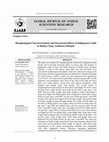
Morphological Characterization and Structural Indices of Indigenous Cattle in Hadiya Zone, Southern Ethiopia, 2019
The study was conducted to morphologically characterize indigenous cattle breeds and to develop s... more The study was conducted to morphologically characterize indigenous cattle breeds and to develop structural indices to assess type and function of indigenous cattle in Soro and Misha districts of Hadiya zone Southern Ethiopia. A total of 660 mature cattle (480 cows and 180 bulls) were selected for morphological description. Data was collection by using visual observation and linear measurements and analyzed by Statistical Package for Social Sciences (SPSS version 20), and compared at the significance level P<0.05. The result showed individual variation among cattle in both qualitative and quantitative traits. Most of the cattle in the study area have plain coat colour pattern, curved horn with upward orientation, small humped and straight facial head profile. The overall results of morphometrical measurements in Soro district had higher (P<0.05) values for their body weight and the chest girth for the bulls in age class 1 and 2PPI. However, body weight, chest girth, height at withers and height at rump were higher for Misha district when compared to those bulls at Soro district for age class 3 and 4PPI. For the cows within age group 1 and 2PPI reared at Soro district have higher (P<0.05) body weight, chest girth, height at withers, height at rump and rump length. The results of body indices of the bulls in Misha district were higher values (p<0.05) for body index for age class 1 and 2PPI and cephalic index and over increase index for age class 3 and 4PPI. While, body ratio was higher (p<0.05) for Misha district for age class 3 and 4 PPI. In contrast, body indices for cows in Soro district was higher (p<0.05) for height index, rump length index, body index, body weight index and body ratio, in contrasting cephalic index, body index, over increase index, body weight index, body ration and height slope were higher(P<0.01) for Misha district for age class 3 and 4PPI. The values for estimation of body weight using linear body measurements indicated that chest girth was best predictor body weight. In general, cattle linear body measurements in the current environmental condition were comparable with other indigenous breeds. Therefore, designing appropriate management and breed improvement programme with the participation of
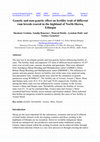
Livestock Research for Rural Development 32 (5) 2020, 2020
The aim was to investigate genetic and non-genetic factors influencing fertility of rams. The fer... more The aim was to investigate genetic and non-genetic factors influencing fertility of rams. The fertility study encompassed 155 rams of different breed mated to 14,357 ewes over several years, seasons, locations and genotypes. Data were obtained from Amedguya Sheep Breeding and Multiplication center (ASBMC), Debre Birhan Sheep Breeding and Multiplication center (DBSBMC). The influences of genetic and non-genetic factors on fertility trait of the rams were analyzed using non-parametric tests. Animal model were used for the estimation of genetic parameters using WOMBAT®. The fertility rate of Awassi, Awassi x Menz, Menz and Dorper rams were 45.4, 53.4, 84.8 and 70.6% respectively. Fertility rate among the Menz rams was not influenced by season, contrary to the Awassi, Awassi x Menz and Dorper rams. Heritability estimates for fertility of Awassi, rams were 0.1. It can be concluded that, Awassi rams and Awassi x Menz crossbred had lower fertility across seasons and location studied. These indicated that further investigation would be needed to identify the cause of low fertility in Awassi breed.
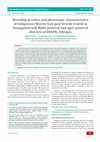
International Journal of Animal Science, 2020
The study was carried to characterize the Woyto-Guji goats reared in two districts (Nyangatom and... more The study was carried to characterize the Woyto-Guji goats reared in two districts (Nyangatom and Malle) of South Omo and also to assess the traits used to select the bucks and does traditionally. The respondents were selected using stepwise purposive followed by random sampling method. The collected data were analyzed using statistical procedures. The qualitative traits were evaluated using non parametric tests. The results indicated that the bucks and does are selected by the community members using traditional descriptors. The traits preferred for selection were those related with adaptation and disease tolerance. The bucks were selected for traits which correlated with their abilities to fend off predators while the does were selected for their mothering and nursing abilities. Coat colors were also considered as important attributes towards selecting the does and bucks, the preferred coat colors were those with white with patchy, red and red with patchy. The selection criteria of breeding doe's were more concerned on their maternal instincts and nursing abilities while body conformation and coat color were the traits preferred for selection of the bucks. Pastoral and agro pastoral preference of coat color patterns were white with patchy, red and red with patchy which were helpful for the goats of the area for the adaptation on the existing hot environment. Therefore, based on their adaptation traits, selection and breed improvement strategies should be developed for the existing environment.

ACTA AGRICULTURAE SCANDINAVICA, SECTION A — ANIMAL SCIENCE, 2020
The present study was conducted to estimate milk production performance and fit lactation curves
... more The present study was conducted to estimate milk production performance and fit lactation curves
for groups of ewes of Local and of Awassi crosses, with a variable blood level, reared under farmer’s
environment. The Weigh-Suckle-Weigh method plus hand milking was used to estimate milk yield
for ewes. A total of 466 observations from 115 ewes were used. Estimated least-squares adjusted
means for the milk production over 120 days were 0.56 kg day−1 (Local), 0.67 (<30% Awassi),
0.86 (30–50% Awassi), and 0.96 (>50% Awassi). Groups with 30–50% Awassi and >50% Awassi
ewes produced significantly (p < 0.05) more milk than Local ewes. Significant differences were
observed between <30% Awassi and >50% Awassi crossbred groups. The best crosses (>50%
Awassi) produced over 70% more milk than the local ewes which demonstrates the potential
that exists in increasing milk production through the initiated crossbreeding programme with
sheep in Ethiopia.
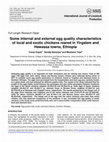
Analyzing eggs quality is so important for both consumers and for coming new chicks. Total of 300... more Analyzing eggs quality is so important for both consumers and for coming new chicks. Total of 300 eggs (100 eggs from each native, Sasso and Bovans brown) chicken were collected during winter of 2017 to evaluate some egg quality parameters of chickens reared at Yirgalem and Hawassa towns of Southern Ethiopia. The eggs were purchased from the householders and each egg was carefully broken on a glass sheet, and was analyzed for different quality traits. The results of the study indicated that the weight of the eggs highly varied between the genotypes and also within genotypes (between locations) the eggs of the native chickens weighed (45.20±5.53 and 39.30±4.04 g), while eggs of Sasso chickens weighed (56.40±7.07 and 56.00±7.2 g), whereas those of Bovans brown weighed (57.80±7.22 and 60.70±5.98 g) at Hawassa and Yirgalem towns, respectively. The results pertaining to the Haugh unit of the eggs (from Hawassa and Yirgalem) and of the native chickens was (74.91±15.78 and 82.55±3.82), while for Sasso chickens (86.50±11.07 and 87.04±11.10) and Bovans brown were (94.60±7.74 and 86.29±5.85), respectively. The Haugh unit of the egg from the native chickens was lower than exotic chicken; this was observed irrespective of the locations. It was concluded that egg quality of exotic chickens in the study areas performed fairly well, but it needs further comparative study under farmers' level and intensive farm.
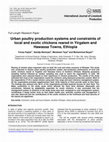
International Journal of Livestock Production, 2019
Rearing of chicken plays important roles on both the rural and urban economy of Ethiopia. This st... more Rearing of chicken plays important roles on both the rural and urban economy of Ethiopia. This study was conducted to assess urban poultry production system and productive performance of local and exotic chickens reared at Yirgalem and Hawassa towns of Southern Ethiopia. Stepwise purposive sampling method followed by random sampling was used to select the respondents. In total, 180 respondents were selected based on their experience in chicken production. The results of the study indicated that most of the respondents reared the chickens using backyard production system. Most of the respondents (77.8%) reared chicken using both free range and semi intensive management system. All the respondents provided supplementary feed, while majority of them provide water to their flock. The findings also showed only 38.3% of the respondents provided separate houses for their flock. The Major constraints in the study areas which affected the flock were diseases (Newcastle and coccidiosis), followed by adaptability especially for exotic chickens. It was concluded that the management system of chickens in the study areas were well, compared to rural management system; nonetheless it needs further work on their better health care, scientific nutrition and management. It was also observed that the contributions of the exotic chickens to the livelihood and food security of the rearers are significant.

Livestock Research for Rural Development., 2019
dis study aims to investigate genetic and non-genetic factors effecting growth performance of Boe... more dis study aims to investigate genetic and non-genetic factors effecting growth performance of Boer goats and their crosses with Central Highland goats (CHG) reared on-station at Ataye site of Debre-Birhan Agricultural Research Center in Ethiopia. A total of 512 kids of Boer (B), F1 (B X CHG) and F2(a) (F1 X F1) crossbreds and backcrosses F2(b) (B X F1) born from 381 kiddings recorded between 2012 and 2017 were used for the analysis of body weight at birth, at weaning, at six-month, at yearling and body weight gain to weaning, weaning to six-month and six-month to yearling. The overall least-squares means across genotypes for birth weight (BW), weaning weight (WW), six-month weight (6MW), yearling weight (YW) were 3.05±0.06 kg, 10.9±0.36 kg, 12.5±0.51 kg and 18.3±0.88 kg, respectively for Boer and 2.62±0.04 kg, 8.80±0.22 kg, 11.2±0.31 kg and 16.7 ±0.48 kg, respectively for F1. Similarly, the BW and WW of the F2(a) and F2(b) were (2.50±0.13 kg and 8.37±0.74 kg) and (2.94±0.15 kg and 9.80±0.75 kg) respectively. The overall least-squares means across breed groups for daily weight gain to weaning, weaning to six-month and six-month to yearling were 83.9±3.76 g, 25.6±3.29 g and 27.6±2.69 g, respectively for Boer, and 67.0±2.26 g, 31.5±2.00 g and 28.4±1.46 g, respectively for F1. Similarly, daily weight gains to weaning was 67.7±7.66 g and 78.7±7.74 g for the F2(a) and F2(b) respectively. Sex, type of birth, year of birth and season of birth effected the studied traits, while, doe parity has no significant effect except at the later age weight gain. In conclusion, the overall growth performances of all the studied genotypes were below expectations which indicates their sub-optimal adaptability to the study area. In addition to the genotype, the non-genetic factors effect the growth performance, so improvement in growth performances is possible by minimizing environmental effects.
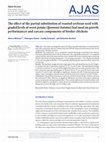
Objective: This study was designed to assess the effects of partial substitution of roasted soybe... more Objective: This study was designed to assess the effects of partial substitution of roasted soybean seed with sweet potato (Ipomoea batatas) leaf meal (SPLM) on growth performances and carcass components of broiler chickens. Methods: The experiment was a completely randomized design consisting of five dietary treatments replicated four times with ten chicks each. The control diet (treatment 1, T1) contained roasted soybean seed as the major protein source without SPLM and treatment diets containing SPLM at the levels of 30 g/kg (treatment 2, T2), 60 g/kg (treatment 3, T3), 90 g/kg (treatment 4, T4), and 120 g/kg (treatment 5, T5) by partially substituting the roasted soybean seed in the control diet. Results: The final body weight and total weight gain of the individual bird was (p<0.01) higher in chickens fed with T1 than those reared on T3, T3, T4, and T5 diets. The individual feed intake in chickens reared in T1 was (p<0.001) higher than those fed on other treatment diets. The feed conversion ratio (kg feed/kg gain) of chickens fed on T1 was (p<0.05) lower than those reared in T4 and T5 diets. Although not significant, chickens fed with T2 diet had numerically higher values of slaughter, dressed carcass and breast than those reared in T4 and T5 diets. Conclusion: The growth performance traits were similar between broiler chickens reared in the control and T2 diets. Moreover, no significant differences were observed in major commercial carcass components among treatment diets. Thus, partial substitution of roasted soybean seed by SPLM might be considered as viable option in smallholder poultry production practices taking into account the high cost of soybean seed.

The study was conducted to assess the traits
traditionally used to select the Bonga sheep reared ... more The study was conducted to assess the traits
traditionally used to select the Bonga sheep reared in
Southern Ethiopia. The breed was included for improvement under the community based breeding program
(CBBP) launched in the year 2009. The results are based
on the data collected from the project between 2009 till
2012. The findings are based on focus group discussions
with the community elders who have been rearing the
Bonga sheep for more than 20 years. The present findings
are based on information obtained from 50% of the total
respondents who were involved in CBBP. The Bonga
sheep is a mutton type breed and the ewes are moderately
prolific. In the past this breed of sheep were bartered to
settle legal disputes and were traded against household
commodities.. However, over the years (and also after the
intervention of CBBP) the sheep have been selected for
their body weight as well as for their distribution in many
parts of Ethiopia The respondents selected the lambs at
both pre weaning and post weaning stages. Traditionally
the traits of rams are selected based on their body length,
canon circumference, broad face, enlarged thyroid, while
for the ewes, traits prolificacy, skin thickness and pelvic
width are determining characters. Fat tail and brown coat
color were preferred irrespective of the sexes in trait
selection. The ram lambs selected for breeding purpose are locally known as ‘‘Dookoo’’. These rams are selected
based on some predetermined phenotypic traits and are
initially selected at preweaning stage and further, again at
the post weaning stage. These rams are preferentially
cared and are provided with supplementary feed and
comfortable housing.
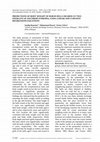
The study pertains to assessment of body weight of Boran bulls reared at two feedlots of Southern... more The study pertains to assessment of body weight of Boran bulls reared at two feedlots of Southern Ethiopia. Boran cattle are raised by the pastoralists under extensive management system and the region lacks even the basic restraining chutes and weighing balances. Thus, the study was conducted to predict the body weight of the bulls reared in two locations of Southern Ethiopia using linear body measurements of bulls aged 2 and 3 years of age and to predict the body weight at 3 and 4 years of age and 4 years of age respectively using linear and some curvefit regression equations. The study was conducted at two locations the first location was devoid of any wind breaks and was bitterly cold in the night which was uncomfortable for the bulls while the second location had well built infrastructures and hence was quite comfortable for the bulls. The results indicated that the morphometical traits and body weight varied across the two locations, indicating a significant genotype by environment interactions for the traits. The findings also indicated that the predictors for assessing the body weight varied according to the age and location. The rump length of the bulls reared at the first location and aged 2 years was significantly correlated with their body weight , while for the bulls aged 3 and 4 years respectively years and reared in the first location the traits significantly correlated with body weight were the heart girth and flank width respectively. While body depth and heart girth respectively were the traits which were significantly correlated with the body weight of the bulls aged 3 and 4 years respectively. The results also indicated that the height at withers and heart girth of the bulls aged 3 years and reared in the first and second locations were best predictors for assessing the body weight of the bulls aged 4 years and in the respective locations. The results also indicated that among the regression equations the accuracy was higher using quadratic regression equations among the bulls across all the age groups. However, the body weight of the bulls aged 3 years and reared at the second location was best assessed using exponential and power regression.
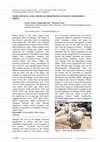
Menz sheep is the only coarse wool producing sheep in Ethiopia. The fleece of this sheep is gener... more Menz sheep is the only coarse wool producing sheep in Ethiopia. The fleece of this sheep is generally used for producing local handicrafts. The fleece was collected from pedigreed Menz sheep reared at Debre Brhan Research center. Fleece samples were collected thrice during the study period following the standard protocols. The physical parameters of the fleece were staple length (SL), crimp/inch, numbers and diameters (μm) of different types of fibers (wooly, hetero and hairy). While, the chemical parameters were, percentages of ash, wool wax and vegetable matters (burr). The samples pertain to both the sexes and different age groups The staple length varied with the sexes and age of the sheep. The numbers of crimps per inch varied from 3.78 to 4.14. The percentage of true fiber varied from 37.0 to 40.7, while those of the hetero and hairy fibers varied between 35.0-3 and 25.83 to 28.29, respectively. The diameter of true, hetero and hairy type fibers (µm) varied between 24.98 and 26.58; 29.62 and 40.74; 61.68 and 89.38 respectively. The percentages of wool wax and scouring yield too varied due to sex and age, with values ranging between 7.93-10.91 and 62.56-68.05, respectively. High coefficients of variation between the traits indicate significant within breed variation and therefore a possibility of selection for fleece related traits.











Uploads
Papers by Sandip Banerjee
for groups of ewes of Local and of Awassi crosses, with a variable blood level, reared under farmer’s
environment. The Weigh-Suckle-Weigh method plus hand milking was used to estimate milk yield
for ewes. A total of 466 observations from 115 ewes were used. Estimated least-squares adjusted
means for the milk production over 120 days were 0.56 kg day−1 (Local), 0.67 (<30% Awassi),
0.86 (30–50% Awassi), and 0.96 (>50% Awassi). Groups with 30–50% Awassi and >50% Awassi
ewes produced significantly (p < 0.05) more milk than Local ewes. Significant differences were
observed between <30% Awassi and >50% Awassi crossbred groups. The best crosses (>50%
Awassi) produced over 70% more milk than the local ewes which demonstrates the potential
that exists in increasing milk production through the initiated crossbreeding programme with
sheep in Ethiopia.
traditionally used to select the Bonga sheep reared in
Southern Ethiopia. The breed was included for improvement under the community based breeding program
(CBBP) launched in the year 2009. The results are based
on the data collected from the project between 2009 till
2012. The findings are based on focus group discussions
with the community elders who have been rearing the
Bonga sheep for more than 20 years. The present findings
are based on information obtained from 50% of the total
respondents who were involved in CBBP. The Bonga
sheep is a mutton type breed and the ewes are moderately
prolific. In the past this breed of sheep were bartered to
settle legal disputes and were traded against household
commodities.. However, over the years (and also after the
intervention of CBBP) the sheep have been selected for
their body weight as well as for their distribution in many
parts of Ethiopia The respondents selected the lambs at
both pre weaning and post weaning stages. Traditionally
the traits of rams are selected based on their body length,
canon circumference, broad face, enlarged thyroid, while
for the ewes, traits prolificacy, skin thickness and pelvic
width are determining characters. Fat tail and brown coat
color were preferred irrespective of the sexes in trait
selection. The ram lambs selected for breeding purpose are locally known as ‘‘Dookoo’’. These rams are selected
based on some predetermined phenotypic traits and are
initially selected at preweaning stage and further, again at
the post weaning stage. These rams are preferentially
cared and are provided with supplementary feed and
comfortable housing.
for groups of ewes of Local and of Awassi crosses, with a variable blood level, reared under farmer’s
environment. The Weigh-Suckle-Weigh method plus hand milking was used to estimate milk yield
for ewes. A total of 466 observations from 115 ewes were used. Estimated least-squares adjusted
means for the milk production over 120 days were 0.56 kg day−1 (Local), 0.67 (<30% Awassi),
0.86 (30–50% Awassi), and 0.96 (>50% Awassi). Groups with 30–50% Awassi and >50% Awassi
ewes produced significantly (p < 0.05) more milk than Local ewes. Significant differences were
observed between <30% Awassi and >50% Awassi crossbred groups. The best crosses (>50%
Awassi) produced over 70% more milk than the local ewes which demonstrates the potential
that exists in increasing milk production through the initiated crossbreeding programme with
sheep in Ethiopia.
traditionally used to select the Bonga sheep reared in
Southern Ethiopia. The breed was included for improvement under the community based breeding program
(CBBP) launched in the year 2009. The results are based
on the data collected from the project between 2009 till
2012. The findings are based on focus group discussions
with the community elders who have been rearing the
Bonga sheep for more than 20 years. The present findings
are based on information obtained from 50% of the total
respondents who were involved in CBBP. The Bonga
sheep is a mutton type breed and the ewes are moderately
prolific. In the past this breed of sheep were bartered to
settle legal disputes and were traded against household
commodities.. However, over the years (and also after the
intervention of CBBP) the sheep have been selected for
their body weight as well as for their distribution in many
parts of Ethiopia The respondents selected the lambs at
both pre weaning and post weaning stages. Traditionally
the traits of rams are selected based on their body length,
canon circumference, broad face, enlarged thyroid, while
for the ewes, traits prolificacy, skin thickness and pelvic
width are determining characters. Fat tail and brown coat
color were preferred irrespective of the sexes in trait
selection. The ram lambs selected for breeding purpose are locally known as ‘‘Dookoo’’. These rams are selected
based on some predetermined phenotypic traits and are
initially selected at preweaning stage and further, again at
the post weaning stage. These rams are preferentially
cared and are provided with supplementary feed and
comfortable housing.